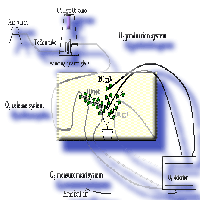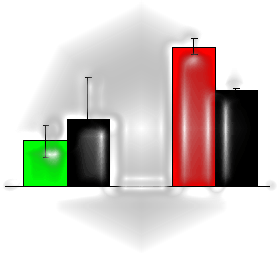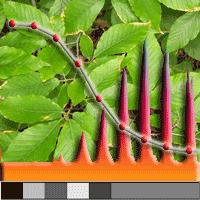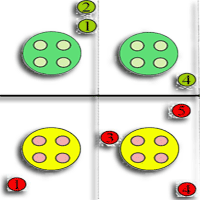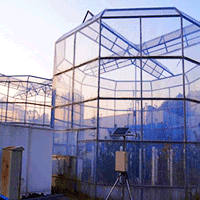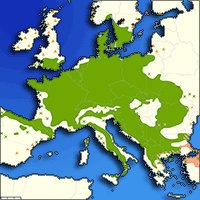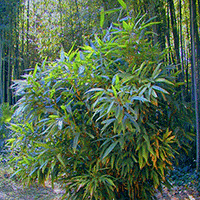
Adaptability of Indocalamus decorus to climate change based on physiological and biochemical responses to elevated carbon dioxide and ozone
Ziwu Guo (1), Minghao Zhuang (2), Yingchun Li (1), Shuanglin Chen (1) , Qingping Yang (1)
iForest - Biogeosciences and Forestry, Volume 9, Issue 2, Pages 311-317 (2015)
doi: https://doi.org/10.3832/ifor1571-008
Published: Oct 22, 2015 - Copyright © 2015 SISEF
Research Articles
Abstract
Carbon dioxide (CO2) and ozone (O3) are important greenhouse gases that contribute to global climate change. The effects of elevated CO2 and/or O3 on plants remain unclear. Plant responses to mixtures of the two gases at high concentrations are likely to be complex. Previous studies have shown that the ability to tolerate elevated levels of the two gases varies among plant species; physiological adaptability in the face of changing atmospheric composition also differs among taxa. However, the effects of mixtures of the two greenhouse gases on the growth and physiology of bamboo are largely unexplored, even though bamboos are important vegetation elements throughout tropical and subtropical regions of the planet. In this study, we used open-topped chambers (OTCs) to double the concentrations of atmospheric CO2 and O3, and examined changes in membrane lipid peroxidation, photosynthetic physiology, and antioxidase activities in Indocalamus decorus leaves. After 103 days of treatment, elevated O3 depressed net photosynthetic rate (Pn) without changing stomatal function, but caused no significant oxidative damage in the leaves. High levels of antioxidase activities were maintained in the leaves, indicating that this species had a strong tolerance to elevated O3. Decreases in reactive oxygen content and antioxidase activity in the leaves highlighted the significant positive effects of elevated CO2 on photosynthesis in I. decorus. When a mixture of both gases was supplied at high concentrations, we detected no oxidative damage, although photosynthetic capacity was reduced. Negative effects of O3 were very marked during the early part of the treatment period, but the effects of CO2 were positive. CO2 mitigated the oxidative damage caused by O3 and promoted the growth of I. decorus. Thus, I. decorus tolerated the two greenhouse gases, and was able to adapt to elevated CO2 and O3 levels. These findings contribute to the current knowledge base on the response of bamboo to global climate change.
Keywords
Antioxidant Enzyme, Carbon Dioxide, Indocalamus decorus, Membrane Lipid Peroxidation, Ozone, Photosynthetic Physiology
Authors’ Info
Authors’ address
Yingchun Li
Shuanglin Chen
Qingping Yang
Research Institute of Subtropical Forestry, Chinese Academy of Forestry, Hangzhou Zhejiang, 311400 (P.R. China)
College of Environmental Sciences and Engineering, Peking University, Beijing 100871 (P.R. China)
Corresponding author
Paper Info
Citation
Guo Z, Zhuang M, Li Y, Chen S, Yang Q (2015). Adaptability of Indocalamus decorus to climate change based on physiological and biochemical responses to elevated carbon dioxide and ozone. iForest 9: 311-317. - doi: 10.3832/ifor1571-008
Academic Editor
Silvano Fares
Paper history
Received: Jan 23, 2015
Accepted: Aug 18, 2015
First online: Oct 22, 2015
Publication Date: Apr 26, 2016
Publication Time: 2.17 months
Copyright Information
© SISEF - The Italian Society of Silviculture and Forest Ecology 2015
Open Access
This article is distributed under the terms of the Creative Commons Attribution-Non Commercial 4.0 International (https://creativecommons.org/licenses/by-nc/4.0/), which permits unrestricted use, distribution, and reproduction in any medium, provided you give appropriate credit to the original author(s) and the source, provide a link to the Creative Commons license, and indicate if changes were made.
Web Metrics
Breakdown by View Type
Article Usage
Total Article Views: 49070
(from publication date up to now)
Breakdown by View Type
HTML Page Views: 41233
Abstract Page Views: 2764
PDF Downloads: 3693
Citation/Reference Downloads: 17
XML Downloads: 1363
Web Metrics
Days since publication: 3696
Overall contacts: 49070
Avg. contacts per week: 92.94
Citation Metrics
Article Citations
Article citations are based on data periodically collected from the Clarivate Web of Science web site
(last update: Mar 2025)
Total number of cites (since 2016): 3
Average cites per year: 0.30
Publication Metrics
by Dimensions ©
Articles citing this article
List of the papers citing this article based on CrossRef Cited-by.
References
Experiment instruction of plant physiology. South China University Technology Press, Guangzhou, China, pp. 54-124. [in Chinese]
Gscholar
Climate change 2007: the physical science basis. Contribution of Working Group I to the 4th Assessment Report of the IPCC (Solomon S, Qin D, Manning M, Chen Z, Marquis M, Averyt KB, Tignor M, Miller HL eds). Cambridge University Press, Cambridge, UK, pp. 18.
Gscholar
The effect of active oxygen on the activity of ACC synthase induced by exogenous IAA. Acta Botantic Sinica 44 (5): 551-556.
Gscholar
Effects of atmospheric ozone stress on photosynthetic physio- response of three dwarf bamboos. Journal of Tropical and Subtropical Botany 20 (3): 263-269. [in Chinese with English abstract]
Gscholar
Stomatal and non-stomatal limitation to photosynthesis in two trembling aspen (Populus tremuloides Michx) clones exposed to elevated CO2 and/or O3. Plant, Cell and Environment 24: 327-336.
CrossRef | Gscholar
Effects of elevated CO2 on lipid peroxidation and activities of antioxidant enzymes in Ginkgo biloba. Chinese Journal of Acta Ecological Sinica 27 (3): 1106-1112. [in Chinese with English abstract]
Gscholar
Effects of elevated CO2 concentration on photosynthetic characteristics of two urban forest species in Shenyang city. Chinese Bulletin of Botany 24 (4): 470-476. [in Chinese with English abstract]
Gscholar
Experimental techniques of plant physiology. Liaoning Technology Press, Shenyang, China, pp. 164-165. [in Chinese]
Gscholar
Physiological response of Indocalamus decorus to simulated atmospheric ozone stress with multiply-increasing concentrations. Journal of Plant Resources and Environment 21 (2): 68-72, 88. [in Chinese with English abstract]
Gscholar

